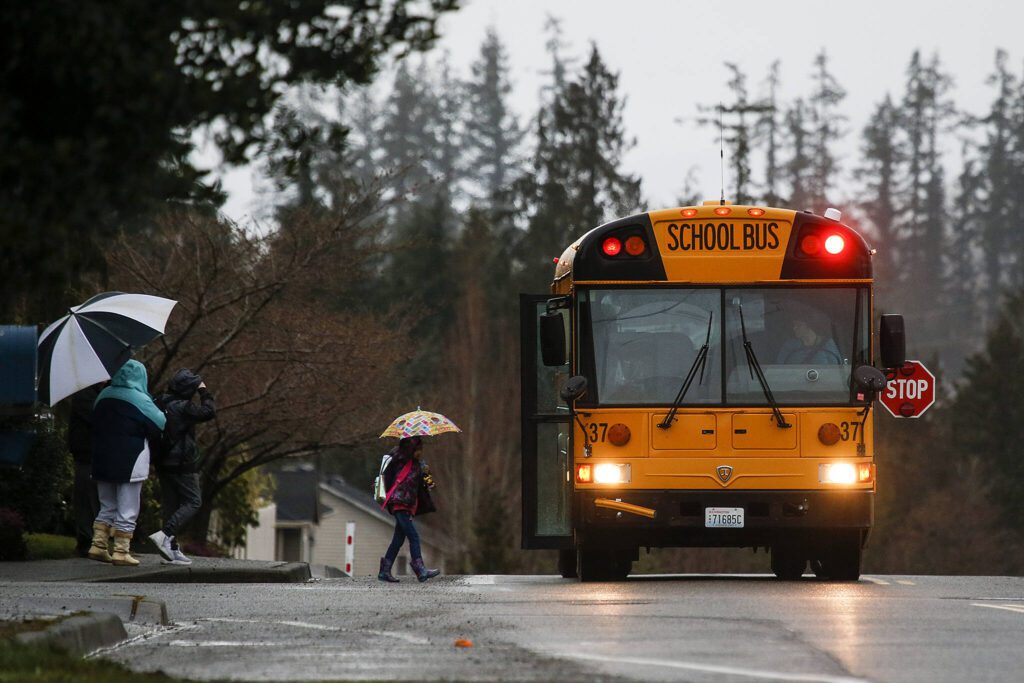MARYSVILLE — The state superintendent’s office has warned the Marysville School District it will face additional oversight if its leaders don’t fix major issues with their financial plan by Wednesday.
Since August, the district has been in so-called “binding conditions,” meaning it must work with the state agency to solve its financial woes. Marysville is the largest school district ever to enter into binding conditions.
But in a letter late last month, the superintendent’s office outlined concerns with the work the district has done so far: fund balance calculations that could be off by as much as $3 million, inconsistent numbers and insufficient money left in the district’s projected fund balance at the end of the 2025-26 school year. An ending fund balance is money left over once expenditures are subtracted from the district’s revenues.
If the district doesn’t submit a revised plan that meets the state’s requirements by Wednesday, the letter cautioned, the state superintendent could go further in overseeing district operations.
That would mean convening a “Financial Oversight Committee” that could come up with an alternate budget plan, approve contracts before the school board does or delay providing some state funding to ensure the district has the required ending fund balance — among other drastic steps.
The state has never convened a committee like this before, said the state superintendent’s chief of staff Tennille Jeffries-Simmons, who wrote the letter. Because of that, it’s unclear how long the committee would last.
District spokesperson Jodi Runyon called the letter “a tool that we can use to take a deeper look in the areas that perhaps we didn’t hit right the first time.”
“The district takes this matter very seriously,” she said, noting the district is on track to meet Wednesday’s deadline.
The stakes are dire.
“The ultimate remedy for a school district that becomes financially insolvent and can’t address that issue is dissolution,” said Larry Francois, superintendent of the educational service district that includes Marysville.
The state convening a financial oversight committee would be “a step along that trajectory,” he said. “I don’t think anybody wants to see that happen, or necessarily expects to see that happen at this point. But that is a possiblity that is out there.”
‘Learning curve’
The district is dealing with an an ongoing financial crisis, with district estimates putting the budget shortfall at $5.9 million in late January.
District revenue took a major hit in 2022 after a double levy failure. A pared-down four-year levy passed last year, but that money didn’t start coming in until last month.
Since entering binding conditions, district officials met with the state, got budget feedback from a consultant and worked with a “special administrator,” whose job was to advise the district.
Runyon said Marysville’s relationship with the state agency has been “very positive.” Jeffries-Simmons said interactions have been “positive and professional.”
These binding conditions are new territory for all involved, Runyon said, given the size of the district and how few other districts are in such a predicament.
“We have been learning from each other throughout this process,” she said.
As the school year has gone on, however, Jeffries-Simmons said “we’ve not seen the level of urgency, or proactive problem-solving or even the transparent communication with stakeholders that we would expect to see from the school district in this situation.”
The Northwest Educational Service District, an intermediary between school districts and government agencies, also plays a role. It is one of nine educational service districts statewide.
Marysville is one of three schools in the local service district in binding conditions with the state. The other two are La Conner and Mount Baker.
Jeffries-Simmons said in Marysville “we just haven’t seen the amount of progress that we have seen in the other school districts in terms of the types of actions and decisions that signal that their financial situation will be resolved.”
Marysville has required a higher level of support than those other two districts, said Francois, of the educational service district. It’s much bigger, and neither La Conner nor Mount Baker have had to contend with a double levy failure.
Marysville has also seen “turnover in key staff,” he said. Superintendent Zachary Robbins is only in his second year with the district and Lisa Gonzales, the district’s executive director of finance, started last July.
“I think their learning curve has just been steeper than the other two districts,” Francois said.
‘Does not comply’
Marysville agreed to supply the state with a financial plan by April 15. The plan had to show the district could recover financially by the end of the 2025-26 school year.
The state agency’s concerns about the district “solidified” when staff reviewed that plan, Jeffries-Simmons said.
Though the district met the deadline, she wrote in the letter last month, the plan “does not comply with the binding conditions agreement.”
The requirement to submit the plan has “been known for many months,” Francois said. “And the requirements of the plan were pretty clear. And the plan that the district submitted did not meet all of those requirements.”
The state has never before rejected a district’s financial plan in this situation, Jeffries-Simmons said.
One problem is a seemingly inaccurate estimate for the 2025-26 ending fund balance.
The state gives out more funding to districts with small enough class sizes in kindergarten through third grade. The plan asks the state to waive that requirement and provide the extra dollars anyway, Jeffries-Simmons wrote in the letter. The district appears to have overestimated its revenue under the assumption the state would agree to do so.
Katy Payne, a spokesperson for the state superintendent’s office, wrote in an email failure to meet the class size requirements would result in “a roughly $1.5 million reduction of state funding per year.”
Runyon pointed out smaller classes mean more staff. That’s “more money that we don’t have in our budget,” she added.
The district’s plan also seems to be counting on revenue from its food service budget going into its fund balance. It projects food service will bring in more than $500,000 in extra cash each year of the two year plan.
But “food service revenue must be spent for food service-related costs,” Payne explained in an email.
That discrepancy means the district could have overestimated its ending fund balance by $1 million, Jeffries-Simmons wrote in the letter.
In an email, Gonzales wrote the state “thought we made an error with food service, but we didn’t. This will be addressed in the revised plan.”
‘Significant discrepancies or errors’
Some numbers in the plan are also inconsistent, the state argued.
Spending estimates don’t line up with numbers reported at other times to the school board and the state agency. The plan lists $4 million in budget reductions in the 2024-25 academic year, but the school board received information listing $6.8 million in reductions for that year just a week later, the letter said.
“Funding balances change all the time, because you’ve got money coming in, you have money going out,” Runyon said. “So those balances and those cash flows are going to change nearly on a daily basis.”
Reducing the deficit is “a continuous process,” she said.
Jeffries-Simmons countered, saying the numbers she referred to in her letter are “calculation errors,” not normal budget fluctuations.
She said the plan contained “significant discrepancies or errors in budget calculations produced by school district staff. And one of the questions that those types of errors raise is around internal review processes and oversight.”
Gonzales wrote in an email that the district “had some corrections to make regarding staffing and different funding sources” after submitting the plan.
“Those corrections were made and will be reflected in the revised plan,” she wrote.
Francois said one reason for the errors is likely “a relatively new fiscal team in the district that I think are still trying to learn the nuances of Washingon state education funding.”
“Because they are in binding conditions, they probably would benefit from having more staff that they could devote to their fiscal operation,” he said. “And more staff costs more money, and that’s why they’re in binding conditions is because they have money challenges. So it’s a little bit of a circular problem for them.”
District policy requires its fund balance each school year equal 5% of its total budget. The state is requiring the district comply with that policy for the 2025-26 academic year. But the plan misses that mark by more than $3 million, the letter said, and is off by $3 million more if the issues with class sizes and food service revenue are taken into account.
The district’s plan cuts into its fund balance instead of adding to it, Payne wrote.
That’s a problem for the state agency.
“Fund balance should not and cannot be used to balance the budget on a regular basis, as it can only be used once,” Payne wrote. The state agency “explicitly says that the district must rebuild its fund balance in accordance with the binding conditions requirements. This means they must increase their fund balance, not decrease it.”
The goal, Jeffries-Simmons said, is to get Marysville’s long-term financial health to a good place. It’s not just about resolving the immediate issues, but “about staying out of binding conditions in the future.”
Marysville teachers union President Becky Roberts said the state’s letter to the district was a positive step in “holding our district accountable.”
Moving forward will be “a process of rebuilding trust,” she said.
The district said it has continued to work with the state agency and service district to come up with a new plan.
“We have a skilled team of individuals working together and looking at multiple ways to resolve the complex challenges of school finance and binding conditions,” a district statement read. “We suspect that our revised plan will be accepted because everyone is working together to positively resolve the challenge of creating a suitable financial plan for all parties.”
Correction: A previous version of this article misstated what a fund balance is.
Sophia Gates: 425-339-3035; sophia.gates@heraldnet.com; Twitter: @SophiaSGates.
Talk to us
> Give us your news tips.
> Send us a letter to the editor.
> More Herald contact information.


























